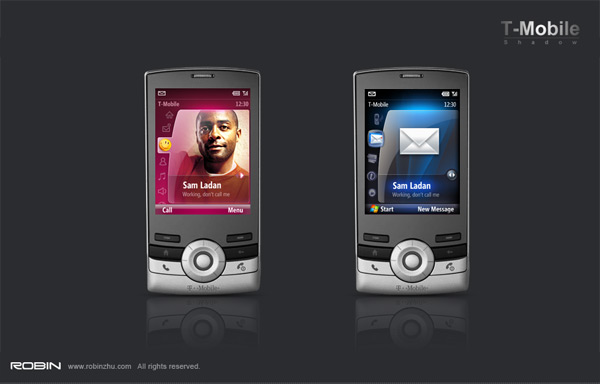
If you’ve been hoping Windows Mobile 7 will bring unification to the user experience of the Windows Phones ecosystem then you should give up and go home immediately.
A recent Microsoft job advertisement signals that the Windows Mobile team will not only support the layer of custom interfaces on most Windows Phones today at an OEM level but will even help create custom interfaces for individual operators comes Windows Mobile 7.
The final responsibility of our group will be working with mobile operators to deliver a unique windows mobile experience that seamlessly integrates the mobile operator’s services (such as voicemail services, video-on-demand services, and navigation services for instance). Microsoft experimented with this back in 2007 with the introduction of the T-Mobile Shadow. That was a great success and with WM7 we will be expanding this effort to more operators. Because of this we will be working heavily on creating custom user interfaces, so passion around UI and graphics programming is a must.
The T-Mobile Shadow was one of the first documented cases where Microsoft not only worked with the operator to design new hardware but actually created a custom-tailored interface in-house to promote some operator-specific services and functionality. Obviously it must have worked out pretty great for T-Mobile and Microsoft they want to do it again with even more operators.
In my opinion, this practice has both advantages and disadvantages. On one hand, every OEM and operator in the ecosystem wants to differentiate their product and this allows them an easy way to do so without resorting to changing the hardware which is more expensive. At the same time however it also means the same device across operators and all devices under the Windows Phone brand will have even less in common – adding more complexity to an already diluted ecosystem.
My fear with such customizations is that eventually the “Windows Phone” will water down to mean nothing more than “Windows Embedded” means for embedded devices – sure it runs Windows CE but you wouldn’t be able to tell (like the Zune HD) and wouldn’t care less. Sure consumers might not care either but it doesn’t make much of a brand if it’s everything and anything.
Update: Hat tip to MobileTechWorld for noticing this 3 months ago.
This was reported 3 months ago here: http://www.mobiletechworld.com/2009/08/07/microsoft-is-building-custom-windows-mobile-7-uis-for-mobile-operators/
I guess they just need to strongly enforce the Windows Phone brand regardless of what customization is done.
Android has custom UI for every manufacturer. Symbian has a different UI for every manufacturer. What is the issue with Win Mo having it?
You know why they did this, right? They’re hoping that if they make it easier for them, the operators will use their tools instead of tearing the thing apart and doing it themselves. That way they get at least some say in what the finished product looks like.
At least that’s how I see it.
Plus, the operators were pushing back in any areas they felt they’d lose some control in. MS will be pushed to comply in order to get their stuff in.
Each phone carrier has its own products, services, and promotions (think “Friends-and-Family” or, in the case of T-Mobile, “Five Faves”) that require custom interfaces. My T-Mobile Shadow shows my five faves on its primary home screen with customized UI for adjusting my own phone personalization (ie choose/change my faves, change photos, position.) Microsoft, I believe, has learned that in order to allow these carriers to better compete with each other, the underlying operating system needs to fade to the background. I chuckle to read that you “fear” users of WinMo7 might not “be able to tell” or “care” what is powering their phone. Isn’t that the goal of an operating system?
I hate the fact that OEMs layer in their own UX on top of the core OS. If you are running TouchFlo 3D on an HTC deivce, see here how to siable it: http://www.bowlesonline.com/my-new-att-tilt-2-by-htc-windows-phone-6-5/
I don’t mind letting carriers/hardware-makers create their own custom UIs or add just a little touch to the basic WinMo interface (T-Mobile Shadow and HTC’s TouchFlo’s are good examples), but Microsoft really needs to give WM7 a wonderful user interface so that companies don’t have to feel the need of dropping their own customizations to ‘make it work’.
The main reason why the T-Mobile Shadow and HTC’s WinMo phones work and sell well, is because they offered a much better alternative interface than Microsoft’s rather shoddy UI work. Is it not obvious?
If WM7 had a great standard UI, there’d be little need for 3rd parties to drop their own interfaces. It’s also important, because developers want to work with mobile phones that are easy to do with, and having a standard interface and OS would really help the cause. Having to do various tricks to make apps work on all WinMo phones is hard and may not even pay off.
A little touch to the UI for additional features or carrier-specifics is fine, but the whole UI shouldn’t have to be made different. It may show Microsoft’s lack of concern about it’s mobile division.
@quickboy-
I am referring to the Windows Phone 6.5 UI. It is light years ahead of 6.1 and much more efficient than TouchFlo. I would even say it is better in term of use and efficiency than the iphone.
i Can’t wait for it to be released together with chrome os so that i can finally decide who if google or microsoft are gonna be the future(at least in my house)